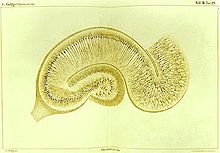Camillo golgi
Bartolomeo Camillo Emilio Golgi (Corteno Golgi, Italy, July 7, 1843 - Pavia, January 21, 1926) was an Italian physician and cytologist. He devised cell staining methods based on silver chromate, a procedure that allowed (both himself and other researchers) to make important discoveries, especially about neurons and their physiology. He received the Nobel Prize in Medicine (jointly with the Spaniard Santiago Ramón y Cajal) in 1906.
Biography
He studied medicine at the University of Pavia, graduating in 1865. He worked for some time in the psychiatric clinic of criminologist Cesare Lombroso, but soon became interested in histology. In 1872 he began working in the incurable ward of a hospital in Abbiategrasso. He served as a professor of anatomy at the Universities of Turin and Siena and as a professor of histology at the University of Pavia, of which he became dean of the Faculty of Medicine and rector.
Despite the limited resources available to him, he achieved important results with his experiments, among which the method of tincture using silver chromate stands out, which was a revolution in the laboratory study of nervous tissue. Using this method, he identified a class of nerve cell with extensions (or dendrites) by which other nerve cells connect to each other. This discovery allowed Wilhelm von Waldeyer-Hartz to formulate the hypothesis that nerve cells are the basic structural units of the nervous system, a hypothesis that would later be demonstrated by Santiago Ramón y Cajal, who developed the neuronal theory.
In 1876, after his return to the University of Pavia, he continued his examination of nerve cells, and obtained evidence of the existence of an irregular network of fibrils, cavities, and granules, which would henceforth be called the apparatus of nerves in his honor. Golgi and plays an essential role in cellular operations such as membrane construction, lipid and protein storage, or particle transport along the plasma membrane.
Between 1885 and 1893, he dedicated his research to the study of malaria, and reached such important results as the distinction between tertian and quartan malaria, as pathologies caused by two different species of the same parasitic protozoan called Plasmodium, as well as the identification of the febrile attack as caused by the release by said organism of spores into the bloodstream.
In 1906 Golgi received the Nobel Prize in Medicine jointly with Santiago Ramón y Cajal (1852-1934) for their studies on the structure of the nervous system.
He died in Pavia, Italy, in January 1926.
Monuments in Pavia
In Pavia there are several places that pay homage to Golgi.
- A marble statue, in a courtyard of the old building of the University of Pavia, in the N.65 of the central "Strada Nuova". In the basement, there is the following inscription in Italian: "Camillo Golgi / patologo sommo / della scienza istologica / antesignano e Maestro / la segreta struttura / del tessuto nervoso / con attempt vigil / surprise e descrisse / qui operò / qui vive / guida e luce ai venturi / MDCCXCamillo Golgi / outstanding pathologist / of histological science / precursor and teacher / secret structure / of nervous tissue / with extenuating effort / discovered and described / here he worked / here he lives / here guide and illuminates future scholars / 1843 - 1926).
- "Hogar de Golgi", also in Strada Nuova, in N.77, a few hundred meters out of the university, just opposite the historic "Teatro Fraschini". It's the house where Golgi spent most of his personal life with his wife Lina.
- The tomb of Golgi is in the Monumental Cemetery of Pavia (viale San Giovannino), near the central lane, just before the great monument to those fallen in the First World War. It is a very simple gravel of granite, with a bronze medallion representing its scientific profile. Near the tomb of Golgi, in addition to his wife, there are two other important Italian medical scientists: Bartolomeo Panizza and Adelchi Negri.
Eponymy
They bear the name of Golgi in their memory:
- Physiology:
- The Golgi apparatus, an oreganoul present in all eukaryotic cells.
- Golgi's biased organ, a sensory receptor organ located in skeletal muscle tendons.
- Golgi cells, granulous layer cells of cerebellum.
- Astronomy:
- The lunar crater Golgi.
Contenido relacionado
Tuberculosis
Gene
Dactyloctenium
